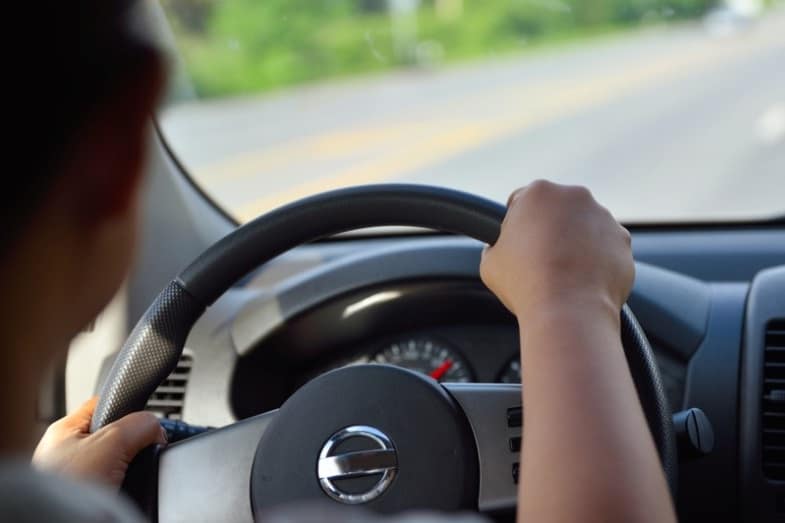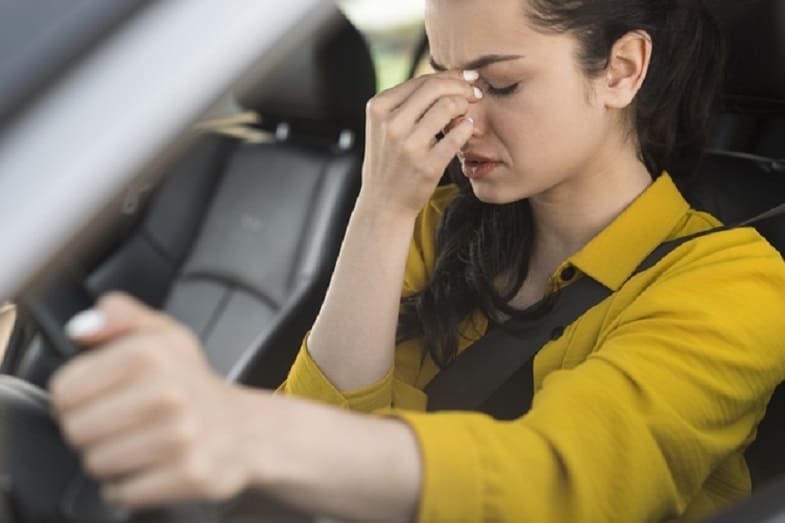A person with 20/200 vision or less is considered legally blind. Does this mean they won’t be able to get a driver’s license? Can you drive if you are legally blind?
A legally blind person cannot receive a normal, unrestricted driver’s license. However, in some states, legally blind people can obtain a restricted driver’s license by taking a complete Driving Evaluation or road test and a recommendation referral from an eye specialist.
A restricted driver’s license may have the following rules, depending on the state:
- No night driving
- No driving on the highway
- Use of corrective lenses
- Use of telescopic lenses
- Issuing shorter term driver’s licenses
- Limited day driving from sunrise to sunset only
- Additional mirrors
Can you drive if you are blind in one eye? If you are blind in one eye, you should be able to get a restricted driver’s license in most states. The restrictions are similar to the above and vary by state.
Read on to learn more about driving while legally blind or blind in one eye.
Can You Drive If You Are Legally Blind?
A legally blind person cannot receive a normal, unrestricted driver’s license. However, in some states, legally blind people can obtain a restricted driver’s license by taking a complete Driving Evaluation or road test and a recommendation referral from an eye specialist.
A legally blind person has a 20/200 vision. It means that they cannot see objects from 200 feet away but can only see them from 20 feet away. But if the person’s vision improves after using corrective contact lenses or glasses, the person is not legally blind.
Normal vision is 20/20 in the U.S. and other countries around the world. With the 20/20 vision, you could vividly see objects from 20 feet away. People with 20/40, 20/50, and 20/60 vision are granted drivers’ licenses and are permitted to drive. Individual states in America have their own vision requirements and restrictions for driving.
The DMV (Department of Motor Vehicles), a driver’s licensing organization, can also grant a driver’s license to people with 20/100 vision. However, they will only issue it if the eye expert or doctor recommends it, along with passing a driving evaluation. Also, the DMV may issue restrictive guidelines for this type of driver.
Visual Function Tests
Horizontal visual field testing requirements also vary in different states. In 16 states, they don’t require horizontal visual field testing unless an eye specialist has evaluated the person after a failed visual acuity test. The 34 other states require a binocular horizontal visual field from 105 to 150 degrees.
Texas and North Carolina will not issue a driver’s license to individuals who have lost half of their vision in their left and right eyes. This condition is called homonymous hemianopia. In many areas, routine or repeat testing typically starts at 65 to 70 years old, while some states do it at 62 years old.
Except for three states, all states have licensure requirements for visual acuity. They have set the minimum requirement for best-corrected visual acuity (BCVA) at 20/40 in the better eye. Wyoming and New Jersey require 20/50 BCVA, while Georgia requires 20/60.
So, in most states, the visual acuity required for an unrestricted driver’s license in the U.S. is a minimum of 20/40 vision based on the scale developed for Snellen Visual Acuity. However, the DMV will request an eye specialist to evaluate and provide advisory for people with a 20/100 vision.
The person will have to undergo a driving evaluation as well. If he passes the assessment, the department may grant restricted driving, such as daylight driving and driving with outside mirrors.
Thus, being legally blind does not necessarily denote not being able to see. It merely means your vision is not perfect for driving.
What Is an Unrestricted Driver’s License?
The state will issue an unrestricted license to applicants who will successfully pass the visual acuity test and driving test. An unrestricted license will allow you to drive to any location, either day or night, in all light conditions, at any distance, at any legal speed, and without corrective lenses in any vehicle (normally equipped) with no additional mirrors.
What Is a Restricted Driver’s License?
A restricted U.S. driver’s license permits the person to drive but imposes certain restrictions on the driver. These restrictions vary based on the applicant’s visual disorder. It also differs from one state to another.

These restrictive rules may include any or all of the following:
- No night driving
- No driving on the highway
- Use of corrective lenses
- Use of telescopic lenses
- Issuing shorter term driver’s licenses
- Limited day driving from sunrise to sunset only
- Driving only in certain areas designated by the state, such as home to church, or home to the supermarket
- Mounting of additional mirrors, such as right and left mirrors outside of the vehicle, or mounted mirror on the fender, or a wide-angle mirror, or a panoramic mirror
Unique Driving Restrictions and Requirements in the U.S.
1. Ohio
In Ohio, aside from the usual restrictions, the state also requires that vision-restricted individuals for testing must consult an eye specialist affiliated with Akron’s Vision Rehabilitation or the Ohio State University’s Optometry School. The applicant should also attend driver’s evaluation and training in either of these institutions. The applicant’s compliance is crucial to the approval of his license.
2. Massachusetts
Massachusetts will only grant a driver’s license if the applicant can distinguish the colors green, amber, and red. The state required this additional qualification to the general requirements.
3. Utah
Utah doesn’t issue a driver’s license to individuals who fail all the vision testing parameters. This rule applies, except in meritorious cases. An authorized body will decide on these cases.
4. Mississippi
If the applicant fails the depth perception test conducted by an eye specialist, Mississippi’s state will restrict the applicant to a maximum speed of 45 miles per hour. Any violation of this rule can jeopardize the person’s application for a driver’s license.
5. Kentucky
Kentucky requires a vertical visual field of 25 degrees below and above the fixation point. It’s the only U.S. state that requires this visual field.
6. Illinois
Illinois has a unique requirement that no other state has. It requires applicants to start taking road tests and annual vision tests when they are 87 years old.
7. California
California accepts applicants with a minimum of 20/200 visual acuity in one eye. However, acceptance does not indicate the issuance of a driver’s license. The person must complete a driving evaluation test and a visual acuity test.
To learn about whether you can drive if deaf, see the article on RoadSumo.com: Can Deaf People Drive?
Can You Drive with Monocular or Binocular Vision Disorder?
Monocular vision loss is an ocular condition of the optic chiasm related to the person’s horizontal midline. Visual impairment is associated with inflammation, mechanical dysfunction, vasculitis, trauma, and ocular infarction. Thus, you have a good vision in only one eye, and you cannot appreciate three-dimensional images. You tend to misjudge distances between your car and other vehicles as well.
Typically, binocular vision loss or disorder represents the vertical midline and originates from the cerebral area. In this condition, the eyes could not align correctly. Hence, the person has to realign them so he can continuously achieve a clear vision. He may see blurred images or experience dizziness, vertigo, and motion sickness.
Can You Drive If You Are Blind in One Eye? (Monocular Vision Disorder)
If you are blind in one eye, you should be able to get a driver’s license in most states. However, you may have certain restrictions that you must follow.
Licensing authorities usually do not grant unrestricted licenses to people with monocular vision (one-eyed drivers). They may be given a conditional license, depending on the type of task they do, whether they pass the driving test or not, and the assessment an eye expert or ophthalmologist conducts every two years.
- The remaining eye’s visual field must have at least 110 degrees within 10 degrees below and above the horizontal midline.
- The remaining eye’s visual acuity is 6/12 or better with or without corrective measures.
Can You Drive with Binocular Vision Disorder (BVD)?
If you have BVD, you’re not fit for an unrestricted driver’s license. Unless your condition is corrected and the eye doctor has given a positive advisory of your eye condition, you should:
- Complete a road driving test.
- Secure a favorable report from an ophthalmologist or eye doctor that you can drive and that you are undergoing continuous evaluation of your eye condition.
For untreated BVD, the licensing body may not issue an unrestricted license.

We’ve answered the question, “Can you drive if you are legally blind?” Now, let’s learn the responsibilities of a health professional who will conduct the eye assessment test.
Responsibility of the Health Professional (Eye Doctor)
The eye doctor, health professional, or ophthalmologist has to inform and advise the applicant of his evaluation results and whether the applicant can drive or not.
The law does not mandate it, but the health professional must report to the driver’s licensing authority if the applicant can inflict damage to themself or the public while driving. This is a moral obligation that everyone concerned in the health community must do without authorities reminding them about it.
For the issuance of conditional licenses, the eye doctor must provide the licensing authority evidence of what criteria were met and not met by the applicant. Also, he must report the monitoring plan and the proposed conditions.
Tips for Driving with Restrictions
- When you’re color blind, you may not be able to differentiate the colors of traffic lights. You must use other means to interpret traffic and road signs, such as shape, the position of signs, and patterns.
- If you have trouble recognizing depths accurately, including three-dimensional objects, such as in monocular vision disorders, you can do the following:
- Avoid freeways.
- Avoid staying too close to other vehicles.
- Allow enough space or area for other vehicles to maneuver.
- In intersections, you may stop too early or stop too late. Be careful about the distances from other vehicles.
- When parking, be careful because you will have the difficulty of not recognizing the correct depth. So, do it slowly and cautiously.
- Avoid driving during nighttime, especially if you have poor night vision. You may not see pedestrians crossing in badly-lit areas or dark road signs.
- When you have poor vision or visual acuity, you may want to get treated first before driving. This method is the best way that you can ensure your safety and the people around you.
- Visit your ophthalmologist or doctor regularly to monitor your progress. Is your vision getting better or worse? These eye check-ups would ensure that you can complete your driving evaluation.
- If you’re not sure of the clarity of your eyes and sharpness of your reflexes, it’s best not to hit the road. Accidents can injure you and other people. What’s more, a mishap may cost you your life.
- Consult a legitimate and competent eye care specialist to treat your vision. Almost all eye disorders can be treated with state-of-the-art technology, medication, or surgery.
- The licensing bodies continually evaluate the status of drivers with restricted licenses. So, be alert and always prepare yourself for these assessments.
Conclusion – Can You Drive If You Are Legally Blind? Can You Drive If You Are Blind in One Eye?
So, to recap, can you drive if you are legally blind? Can you drive if you are blind in one eye? You can drive in some states if you are legally blind or blind in one eye. You will get a restricted driver’s license with certain rules that you must follow. You will not get a normal, unrestricted license.
A restricted driver’s license may have the following rules, depending on the state:
- No night driving
- No driving on the highway
- Use of corrective lenses
- Use of telescopic lenses
- Issuing shorter term driver’s licenses
- Limited day driving from sunrise to sunset only
- Additional mirrors
You can get a restricted driver’s license if you complete a driving evaluation and obtain an advisory from an eye doctor.
Driver licensing authorities consider a person legally blind if they have a best-corrected visual acuity (BCVA) of 20/200 or less. This vision is deemed to be reduced. The state usually doesn’t issue driver’s licenses to people who are legally blind. So, if these people drive, the law can punish them.
However, exceptions to the rule are in place if you have 20/100 BCVA and passed the driving and vision tests. There are restrictions, though, to this type of driver’s license, as mentioned above.
All U.S. states require a minimum of 20/40 BCVA, except for Wyoming and New Jersey at 20/40 and Georgia at 20/60. You have to constantly check announcements from your local licensing body for any modifications to the existing driving policies.



